Tom's Hardware Verdict
Although it may not look like it, the T-Force Vulcan Eco DDR5-6000 C30 is a high-performance memory kit with a low environmental impact thanks to the reutilization of recycled materials.
Pros
- +
Excellent Intel performance
- +
Tight timings
- +
Intel XMP 3.0 and AMD EXPO support
- +
Recycled aluminum
Cons
- -
Lower performance on AMD platforms
- -
Slightly more expensive than the competition
Why you can trust Tom's Hardware
Vendors often find ways to differentiate their products from their rivals. Regarding memory, some brands opt to put more RGB lights on memory modules, while others put small cooling fans or waterblocks on them. TeamGroup, on the other hand, decided to go down a different path — one that's more environmentally friendly.
Launched in 2023, the Vulcan Eco series uses recycled materials to fabricate the aluminum heat spreader. With the Vulcan Eco lineup, TeamGroup aims to promote environmental sustainability and responsibility. Unfortunately, variety is slim as the Vulcan Eco series is only available in a 32GB (2x16GB) capacity and only two data rates to choose from: DDR5-6000 (C38 or C30) and DDR5-5600 (C40 or C36).

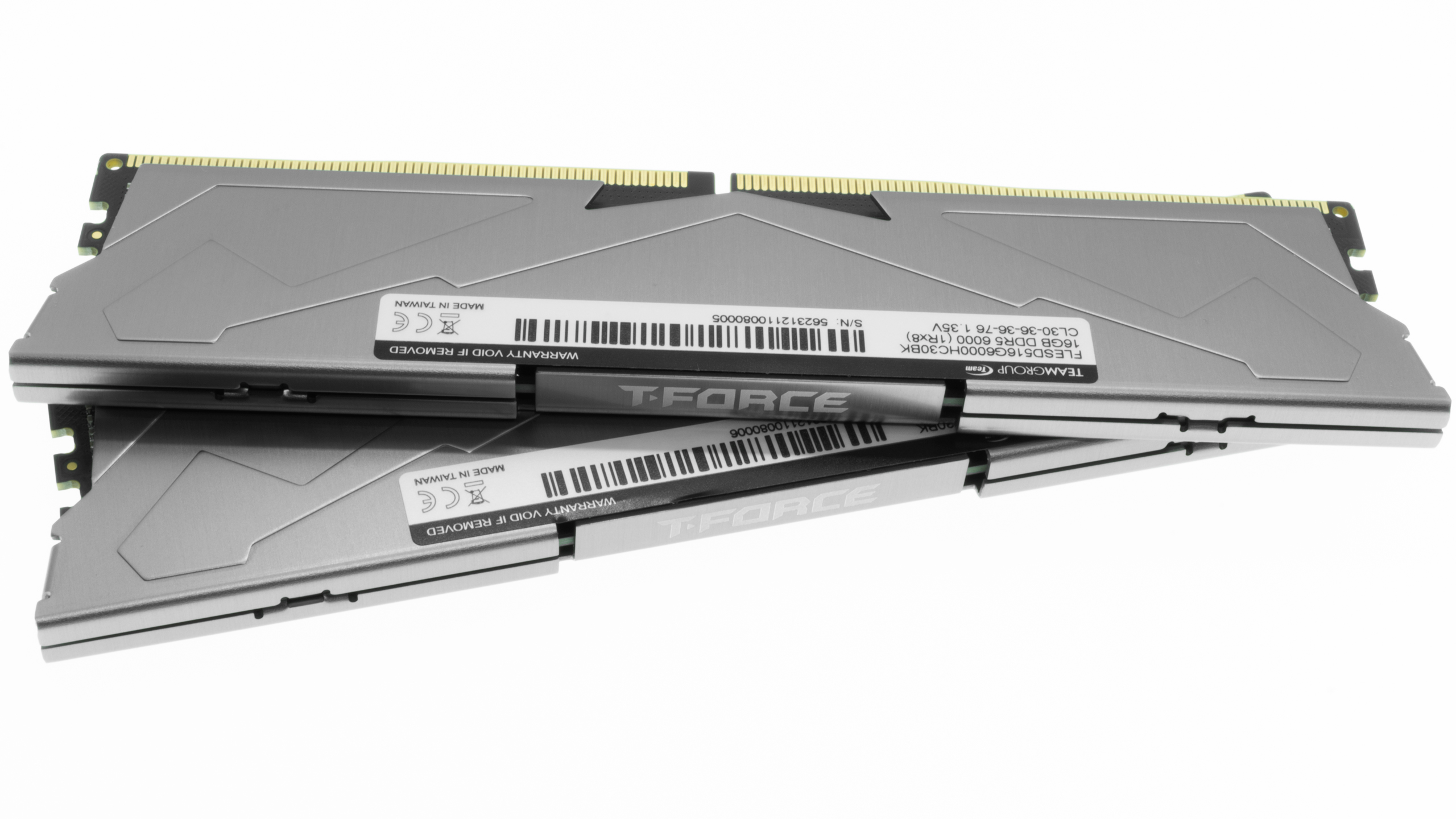
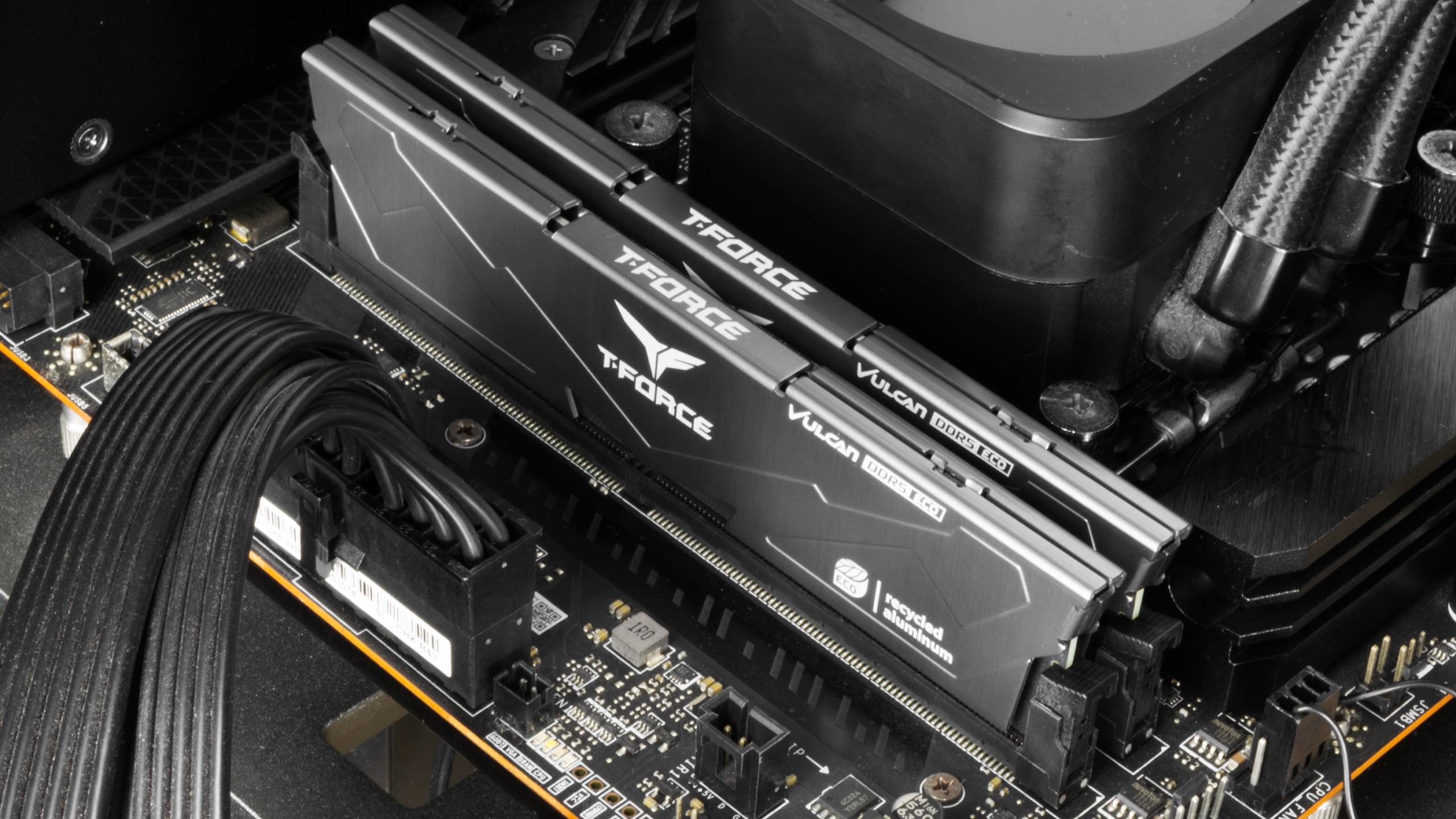
TeamGroup bills the Vulcan Eco series as the first eco-friendly DDR5 memory kit on the market. The heat spreader, which only comes in silver, resembles the design of the brand's regular Vulcan DDR5 memory modules. As the name implies, the biggest differentiator with Vulcan Eco is using recycled materials. The heat spreader pridefully sports the Eco logo and "recycled aluminum" marking. At a height of 1.29 inches (32.7mm), the Vulcan Eco retains the same compact form factor as the other Vulcan-branded lineups.
The Vulcan Eco memory features a heat spreader manufactured with 80% recycled aluminum. According to TeamGroup, every 10,000 heat spreaders produced reduces carbon emissions by 73%. To put the number in perspective, this is equivalent to the carbon footprint of 550,000 hand towels, 310,000 plastic straws, 30,000 plastic bags, and 10,000 PET bottles. TeamGroup also utilizes FSC-certified eco-packaging for the Vulcan Eco memory kits.


TeamGroup only sells the Vulcan Eco in 32GB memory kits. Therefore, each memory kit has two 16GB memory modules with a single-rank design. Specifically for the DDR5-6000 C30 SKU, the vendor is utilizing SK hynix H5CG48AGBDX018 (A-die) integrated circuits (ICs). There are eight A-die ICs under the silver heat spreader, so each has a capacity of 2GB. Taiwanese manufacturer Richtek makes the 0P=AH QG4, the power management IC (PMIC) on the Vulcan Eco.
The stock settings on the Vulcan Eco are DDR5-4800, with timings configured to 40-40-40-77. The memory has XMP 3.0 and AMD EXPO support. The main profile is for DDR5-6000 and 30-36-36-76 timings with a 1.35V. Meanwhile, the secondary profile sets the memory to DDR5-5600, the timings to 40-40-40-84, and the DRAM voltage to 1.2V. See our PC Memory 101 feature and How to Shop for RAM story for more timings and frequency considerations.
Comparison Hardware
| Memory Kit | Part Number | Capacity | Data Rate | Primary Timings | Voltage | Warranty |
|---|---|---|---|---|---|---|
| Corsair Vengeance RGB DDR5 | CMH32GX5M2B6000Z30 | 2 x 16GB | DDR5-6000 (EXPO) | 30-36-36-76 (2T) | 1.40 | Lifetime |
| TeamGroup T-Force Vulcan Eco | FLESD532G6000HC30DC01 | 2 x 16GB | DDR5-6000 (XMP & EXPO) | 30-36-36-76 (2T) | 1.35 | Lifetime |
| G.Skill Trident Z5 Neo RGB | F5-6000J3038F16GX2-TZ5NR | 2 x 16GB | DDR5-6000 (EXPO) | 30-38-38-96 (2T) | 1.35 | Lifetime |
| G.Skill Ripjaws S5 | F5-6000J3238F16GX2-RS5K | 2 x 16GB | DDR5-6000 (XMP) | 32-38-38-96 (2T) | 1.35 | Lifetime |
| Lexar Ares RGB | LD5FU016G-R6000GDGA | 2 x 16GB | DDR5-6000 (XMP & EXPO) | 34-38-38-76 (2T) | 1.30 | Lifetime |
| G.Skill Trident Z5 RGB | F5-6000U3636E16GX2-TZ5RS | 2 x 16GB | DDR5-6000 (XMP) | 36-36-36-76 (2T) | 1.30 | Lifetime |
| Corsair Vengeance RGB DDR5 | CMH32GX5M2D6000C36 | 2 x 16GB | DDR5-6000 (XMP) | 36-36-36-76 (2T) | 1.35 | Lifetime |
| Crucial Pro Overclocking | CP2K16G60C36U5W | 2 x 16GB | DDR5-6000 (XMP & EXPO) | 36-38-38-80 (2T) | 1.35 | Lifetime |
| TeamGroup T-Force Deltaα RGB | FF7D532G6000HC38ADC01 | 2 x 16GB | DDR5-6000 (EXPO) | 38-38-38-78 (2T) | 1.25 | Lifetime |
| TeamGroup T-Force Vulcanα DDR5 | FLABD532G6000HC38ADC01 | 2 x 16GB | DDR5-6000 (EXPO) | 38-38-38-78 (2T) | 1.25 | Lifetime |
| Adata XPG Lancer RGB | AX5U6000C4016G-DCLARBK | 2 x 16GB | DDR5-6000 (XMP & EXPO) | 40-40-40-76 (2T) | 1.35 | Lifetime |
| TeamGroup T-Force Delta RGB | FF3D516G6000HC40ABK | 2 x 16GB | DDR5-6000 (XMP) | 40-40-40-80 (2T) | 1.35 | Lifetime |
Our Intel test system runs the Core i9-13900K on the MSI MEG Z690 Unify-X with the 7D28vAF firmware. In contrast, the AMD system pairs the Ryzen 7 7700X with the MSI MPG X670E Carbon WiFi updated to the 7D70v1E5 firmware. The Corsair CUE H100i Elite LCD liquid cooler keeps our Raptor Lake and Zen 4 processor operating temperatures under check.
The MSI GeForce RTX 4080 16GB Gaming X Trio tackles the more graphics-intensive workloads, ensuring that there isn't a graphics bottleneck in our gaming RAM benchmarks. The Windows 11 installation, benchmarking software, and games reside on Crucial's MX500 SSDs. Meanwhile, the Corsair RM1000x Shift ATX 3.0 power supply provides our systems with clean and abundant power, directly feeding the GeForce RTX 4080 with a native 16-pin (12VHPWR) power cable. Lastly, the Streacom BC1 open-air test bench is vital to organizing our hardware.
Get Tom's Hardware's best news and in-depth reviews, straight to your inbox.


| Component | Intel System | AMD System |
|---|---|---|
| Processor | Intel Core i9-13900K | AMD Ryzen 7 7700X |
| Motherboard | MSI MEG Z690 Unify-X | MSI MPG X670E Carbon WiFi |
| Graphics Card | MSI GeForce RTX 4080 16GB Gaming X Trio | MSI GeForce RTX 4080 16GB Gaming X Trio |
| Storage | Crucial MX500 500GB, 2TB | Crucial MX500 500GB, 2TB |
| Cooling | Corsair iCUE H100i Elite LCD | Corsair iCUE H100i Elite LCD |
| Power Supply | Corsair RM1000x Shift | Corsair RM1000x Shift |
| Case | Streacom BC1 | Streacom BC1 |
Intel Performance























The Vulcan Eco was the fastest DDR5-6000 memory kit that has gone through the Intel test system. It didn't come in first in every workload, but It topped the overall charts in application performance. The memory kit wasn't so shabby in gaming performance, either, reaching the top five.
AMD Performance


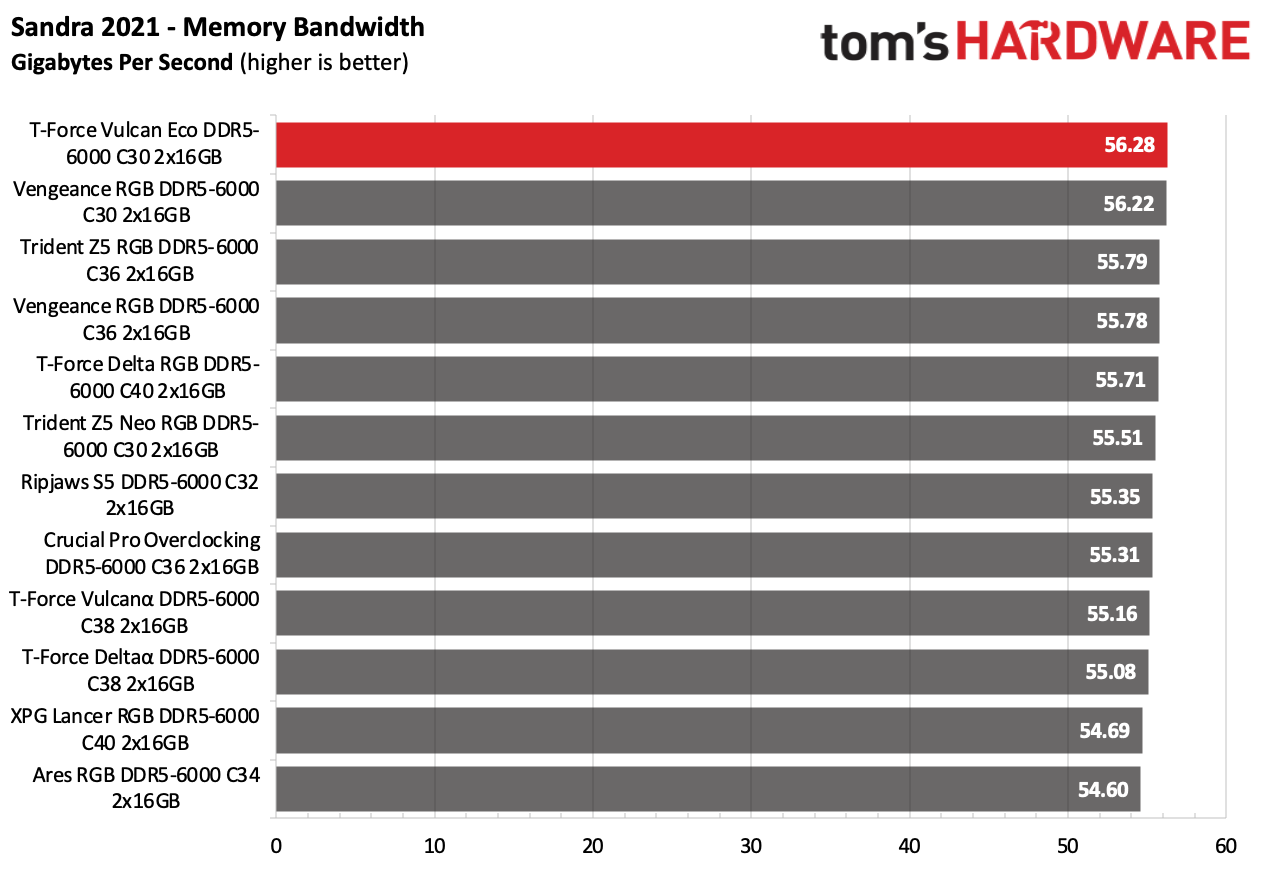








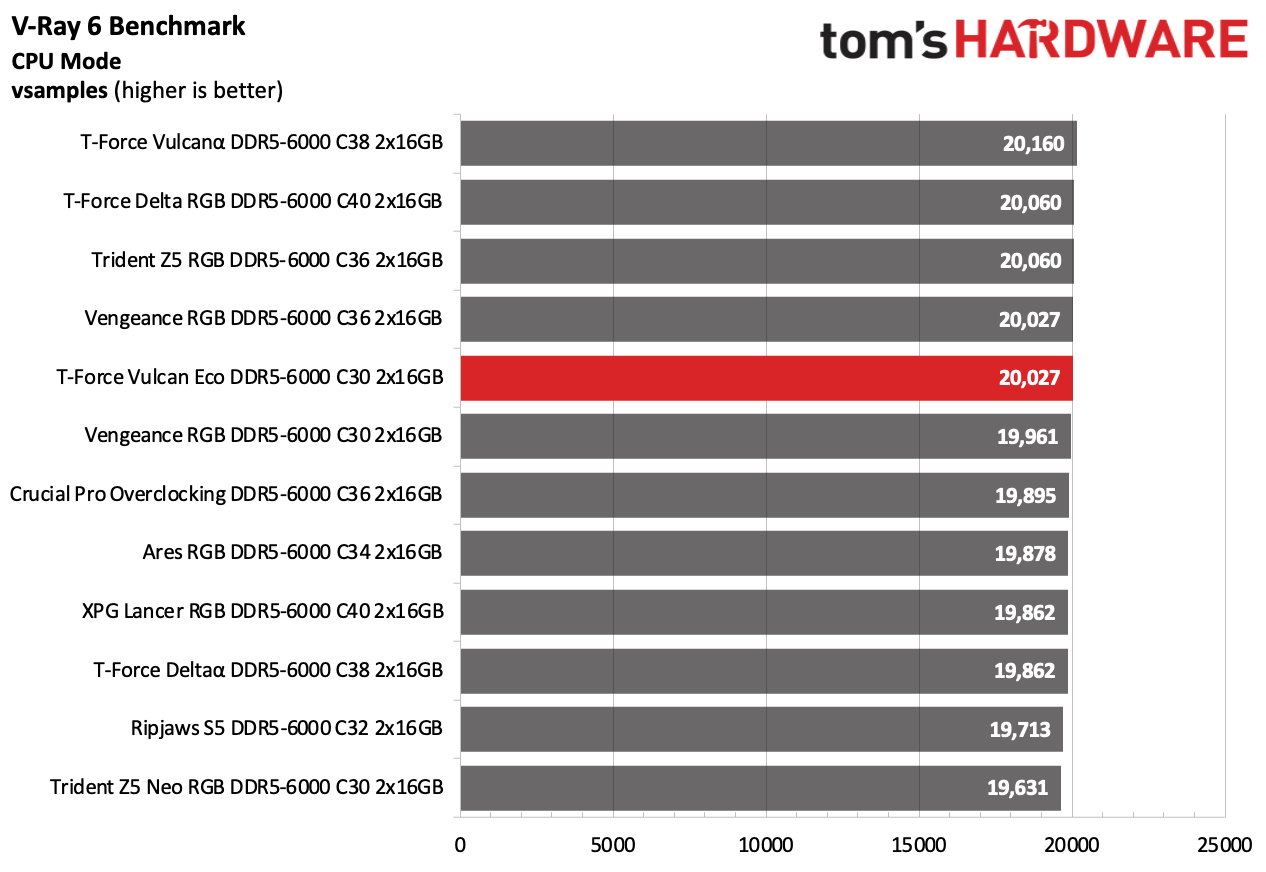
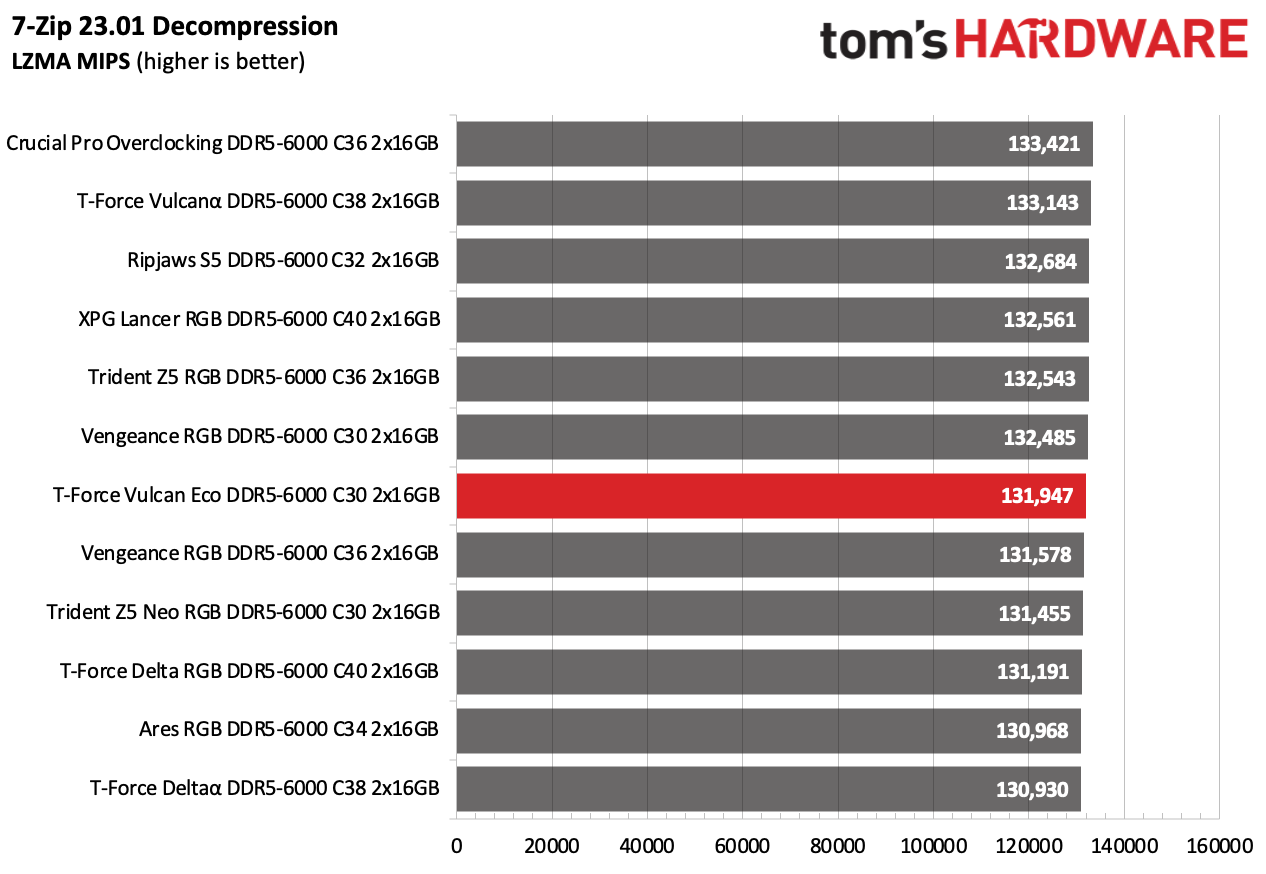










As often happens, the Vulcan Eco memory kit couldn't keep up with performance on the AMD platform. It dropped to fifth place on the overall application performance chart. However, it did take the gaming crown on the AMD system.
Overclocking and Latency Tuning

Increasing the DRAM voltage by 0.05V got us to DDR5-6200 on the Vulcan Eco memory modules. It exhibited similar overclocking margins as the Trident Z5 Neo RGB DDR5-6000 C30. However, the Vulcan Eco could run with tighter timings than the Trident Z5. If we were to relax the timings, the memory kit shouldn't have any problem hitting DDR5-6400, given that it uses SK hynix A-die ICs.
Lowest Stable Timings
| Memory Kit | DDR5-6000 (1.4V) | DDR5-6200 (1.4V) | DDR5-6400 (1.4V) |
|---|---|---|---|
| G.Skill Ripjaws S5 DDR5-6000 C32 | 28-34-34-74 (2T) | N/A | 32-38-38-96 (2T) |
| Corsair Vengeance RGB DDR5-6000 C36 | 34-34-34-74 (2T) | N/A | 38-38-38-78 (2T) |
| TeamGroup T-Force Vulcan Eco DDR5-6000 C30 | 28-36-36-76 (2T) | 30-36-36-76 (2T) | N/A |
| G.Skill Trident Z5 Neo RGB DDR5-6000 C30 | 30-36-36-96 (2T) | 30-38-38-96 (2T) | N/A |
| G.Skill Trident Z5 RGB DDR5-6000 C36 | 36-33-33-73 (2T) | 36-36-36-76 (2T) | N/A |
Even though the Vulcan Eco already boasts steller timings for DDR5-6000, there was some leeway for further optimization. Once we upped the DRAM voltage from 1.35V to 1.4V, it was possible to lower the CAS Latency (CL) by two clock cycles. It resulted in the memory kit running at 28-36-36-76 instead of the default 30-36-36-76.
Bottom Line
It's always stimulating when manufacturers develop new things - or at least things the competition hasn't done. Instead of putting another ostentatious memory kit on the market, TeamGroup released an eco-friendly one with the T-Force Vulcan Eco DDR5-6000 C30. Utilizing a heat spreader with 80% recycled aluminum isn't miraculously going to solve global warming. Many may even argue that not using a heat spreader in the first place would result in less ecological impact. Nevertheless, it's always good to see vendors taking sustainability into account when developing a new product.
The T-Force Vulcan Eco DDR5-6000 C30 isn't just eco-friendly; the memory kit is speedy, especially on Intel platforms. Regarding pricing, the memory kit certainly isn't the most affordable on the market. The T-Force Vulcan Eco DDR5-6000 C30 retails for $99.99, which may be a bummer for some in a market where DDR5-6000 C30 memory kits start at $92. Surprisingly, TeamGroup didn't go with a lower MSRP, considering that the memory kit uses some recycled material in its production.
- MORE: Best RAM
- MORE: DDR DRAM FAQs And Troubleshooting Guide
- MORE: All Memory Content

Zhiye Liu is a news editor, memory reviewer, and SSD tester at Tom’s Hardware. Although he loves everything that’s hardware, he has a soft spot for CPUs, GPUs, and RAM.
-
FelixKD "As often happens, the Vulcan Eco memory kit couldn't keep up with performance on the AMD platform."Reply
What do you mean by that, and why does this "often happen"? And are these not ultimately just measurement variations (as indicated also by the kit taking the top spot in gaming performance on the same system)? Or is AMD more picky and complicated about selecting RAM?
In any case, if you think this is a common phenomenon, it would be worth clearer sentences. -
Solid_Wolf Reply
The remark doesn't make sense. In comparison to the Intel system, the ECO scored lower on the AMD system, but so did every other kit tested, and the ECO was a measly 10 points lower than the highest score. And since the ECO won in gaming, overall, I'd call it the winner among the kits tested. However, the review is correct about pricing, as the T-CREATE EXPERT has the same specs and costs less. And there are even cheaper DDR5-6000 CL30 kits, albeit with slightly looser timings.FelixKD said:"As often happens, the Vulcan Eco memory kit couldn't keep up with performance on the AMD platform."
What do you mean by that, and why does this "often happen"? And are these not ultimately just measurement variations (as indicated also by the kit taking the top spot in gaming performance on the same system)? Or is AMD more picky and complicated about selecting RAM?
In any case, if you think this is a common phenomenon, it would be worth clearer sentences.
